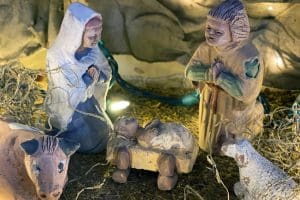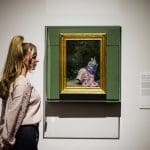 Women at the Well by Liz Lemon Swindle used with permission from Foundation Arts
Women at the Well by Liz Lemon Swindle used with permission from Foundation Arts
As Mother’s Day approaches my thoughts naturally turn to my own mother. Each year I struggle to find the perfect gift and most years I come up short. This is not surprising considering all that my mom has done for me. She had an angel’s touch that instilled in me a sense of importance and worth that guides and directs me to this day. She taught me how to live my life by watching her live hers. She was fun, focused, faithful, and fiery and seemed to embody Thoreau’s adage to “suck out all the marrow of life.”
This year, my mind has wandered back to a gift my mother gave me as a child. It was a gift she used to teach me what mattered most to her and what she expected to matter most to me – and all without saying a word. As a parent, I have come to value her gift even more as I work to teach my kids what matters most. Her gift was art.
“How does art teach children what matters most?” you might be saying to yourself.
It began when I was eight years old. My mother took me to a little gallery in Santa Rosa, California. I had never been in an art gallery before. She didn’t tell me to keep my hands off the bronzes or to back up from the pictures. She just let me wander and asked questions about what I liked and what I didn’t like. I actually believe she was interested in what I thought (mom always had a way of making you feel like you were the most important person in the world).
 Woodland Encounter by Bev Doolittle used with permission from the Greenwich Workshop
Woodland Encounter by Bev Doolittle used with permission from the Greenwich Workshop
We stopped in front of a print by Bev Doolittle. In the picture a fox sits in the middle of a forest. His bright orange coat draws your eye to him immediately. My mom asked, “What do you see?”
“A fox.”
“What else?”
“A forest.”
“Anything else?”
I shook my head, then she continued, “Do you see the two Indians on horses?”
I looked and looked by couldn’t see them. Then she leaned over and pointed and a smile came to my face. It was at that moment I realized that art was not just a part of my world… it was a part of me.
Because I had grown up with an artistic mother many of my experiences were different from my friends. I remember the first time I realized that everyone’s motherdidn’t have an easel in the basement, look at art books,orlove the smell of oil paints and turpentine.
As I grew older I understood that my experiences were unique and I mistakenly thought the affect that art had upon me was a product of my unusual upbringing. Then one day I was speaking with a friend. I commented that even twenty years after leaving my parent’s home I couldstill remember the art that hung there while I was growing up. I could even remember the art in my grandfather’s home.”
 Picture of the First Vision that hung in my grandfather’s home.
Picture of the First Vision that hung in my grandfather’s home.
He smiled and said, “So can I.”
He then describedin vivid detail the different pictures of Jesus cut out of magazines, landscapes painted by his relatives, and even little sayings his mother had taped to the bathroom mirror. I asked him if he could remember the color of the carpet or the style of the sofas. He shook his head.
That night I went home and related to my wife the experience. She smiled and said that she too could remember the art that hung in her parent’s home. Since that day, I have asked hundreds of people the same question. Almost universally they remember the art from theirchildhood homes. Even more surprisingly, most people have strong memories and feelings tied to those pictures. It would seem that my “unique” experience with art was anything but.
When I asked others why they thoughtart had such a powerful effect on them the answer wentsomething like, “It reminds me of my father,” or, “I remember how much my mother loved it and how much it meant to her.” Art was a powerful connection to their parents and to the values that their parents held.
Art is truly the universal communicator. It crosses language, cultures, and even time. One can look at the Sistine Chapel 500 years after it was painted and still be moved and inspired by its beauty. Art is one of the most effective ways to communicate our values. When we display artwork that has touched or inspired us we are showing our children what we want them to value and cherish.
 Spring at the Bountiful Temple by Robert A. Boyd
Spring at the Bountiful Temple by Robert A. Boyd
The Church Handbook of Instructions states (emphasis added):
“Wherever Church members live, they should establish a home where the Spirit is present. All members of the Church can make efforts to ensure that their place of residence provides a place of sanctuary from the world. Every home in the Church, large or small, can be a “house of prayer, a house of fasting, a house of faith, a house of learning, a house of glory, a house of order, a house of God” (D&C 88:119). Church members can invite the Spirit into their homes through simple means such as wholesome entertainment, good music, and inspiring artwork (for example, a painting of the Savior or a temple).”
Although growing up we had little in the way of worldly goods, my mother gave usthe priceless gift of establishing a home where inspiring artwork was away of life. I am reminded of the words or early Mormon artist, John Hafen:
“The influence of Art is so powerful in shaping our lives for a higher appreciation of the creations of our God that we cannot afford to neglect an acquaintance with it. We should be as eager for its companionship as we are eager for chairs to sit upon or for food to sustain our lives, for it has as important a mission in shaping our character and in conducing to our happiness as anything that we term necessities.”
 Hollyhocks by John Hafen Too often we think that art is a luxury reserved for the wealthy or refined.
Hollyhocks by John Hafen Too often we think that art is a luxury reserved for the wealthy or refined.
We may feel intimidated that we don’t know enough about art to determine was is “good”. It reminds me a woman who came into our gallery some years ago. She looked uncomfortable as she wandered around and then quickly headed for the door. Before she left I asked her which paintings she liked. She replied, “I don’t know what’s good. I’m not really into art.”
“The question is not whether you are into art,” I said, “but rather is art into you.”
I explained that she did didn’t need an advanced degree in Art History to determine which art was good, she just needed to listen to her feelings. I then took her back around the gallery and asked her which pictures inspired her. She stopped in front a painting of three vases filled with flowers entitled Faith, Hope, and Charity. I explained the meaning behind each type of flower and how each symbolized one of the virtues in the title.
 Faith, Hope, and Charity by Chris Young
Faith, Hope, and Charity by Chris Young
“Is this good art?” she asked.
“Does it inspire you?”
“Yes.”
“Then it’s good art.”
She smiled and walked out with the picture. That was five years ago. Since then she has been back to the gallery dozens of times. She continues to fill her home with art that inspires her and teaches her children what matters most. Each time we laugh about that first meeting and each time she thanks me for the gift that art is in her life. I smile and tell her that I am just passing along the gift my mother gave me all those years ago.
And so this Mother’s Day, I encourage each of us to take a walk around our homes. Does the art reflect what matters most to us? Does it inspire and uplift us or does it merely match the sofa?
As I finished this article it struck to me that the perfect gift for my mom this Mother’s Day was to let her know just how much her gift of art has meant to me. I collected several of her paintings that have had such a powerful impact on me and set them to music.
Happy Mother’s Day, mom.
May we each give a gift this Mother’s Day that truly matters. May we “invite the Spirit into [our] homes through simple means such as wholesome entertainment, good music, and inspiring artwork.”
To view a video on how to begin to build a house of faith using art go to:www.ldsart.com

















